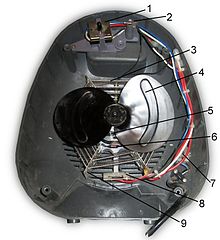Fan heater
A fan heater or electric heater is an electrically operated heating element with a fan to heat the air flowing through it. In Central Europe, due to the high electricity costs, fan heaters are usually only used as a (temporary) supplement or as an emergency replacement for conventional heating .
Practical operation
Standard devices have a switchable heating output of 1,000 or 2,000 W , more expensive devices can also be continuously regulated using a thermostat . Fan heaters are not without controversy, but they have some advantages.
Advantages:
- low purchase price
- compact dimensions
- flexible application and easy installation
- neither gas connection nor heating pipes necessary
- quick heat
Disadvantage:
- high electricity price (no night electricity possible)
- Heating with electricity has a low overall efficiency when the electricity is generated from fossil fuels.
- Raising dust
- Fan creates unpleasant drafts
- Blower noise
Fan heaters are justified as additional heating or in very little used or small rooms, which is why they are often found in guest toilets, guest rooms, hobby and basement rooms, small workshops and as a frost protection measure in rooms without heating. Often there are only a few alternatives for these areas of application.
construction
The heating in devices for use in a domestic environment usually consists of a bare wire heating element in which the live heating resistor is attached directly to the air flow. For more difficult conditions, e.g. B. on construction sites, instead of the bare wire heating element, a more robust tubular heating element is used, which at the same time enables a higher degree of protection against the ingress of foreign bodies. Today a ceramic heating plate is often used, which does not get as hot as the wire or the coil, so it is safer to use.
The propeller is mostly driven by a shaded pole motor.
A selector switch can be used to choose between several heating capacities and fan operation without heating. Some devices have a timer to switch off the fan heater after a certain time.
In addition to the self-resetting, fixed temperature switch for overheating protection, there is also a temperature fuse that irreversibly destroys the device if the temperature is too high. In order to prevent overheating caused by tipping over, current fan heaters usually have an integrated anti-tip device that switches off the device as soon as the device base no longer touches the floor: A switch is integrated in the device base that interrupts the power supply when the sensor pin is no longer open rests on the floor.
The housing is usually made of plastic, more rarely of metal. For the supply and discharge of air, the louvres (air slots) are sometimes designed in such a way that they also promote the circulation of the room air.
Due to the good air circulation, the room is heated up quickly, but on the other hand dirt and dust are whirled up, especially since fan heaters are almost always on the floor. What is more, the warm air dries out the airways.
In addition to portable devices, there are also models for fixed wall mounting. They are mainly used in bathrooms, where there is a risk of a mobile device coming into contact with water if it is not positioned correctly. With some of these devices, the housing is deliberately shaped so that it cannot be set up freely, but only operated when it is permanently installed.
Hazards and instructions for use
When operating a fan heater, make sure that it is free and that the air flow is not obstructed. Trapped heat (due to insufficient intake air or blocked exhaust air path) quickly leads to overheating of the device and its shutdown or, if it does not work, to fire . Therefore, fan heaters must have a secure stand and ideally be equipped with an anti-tip device.
Fan heaters are typically among the major consumers in the home. Because of this, they draw a high current and can overload an inferior socket strip connected to other consumers. Some types of fuses trigger too slowly when overloaded, which is why a fire can still occur in extreme cases.
If the fan heater is to be used as a frost protection measure, the device should have a frost monitor function.
For heating purposes in bathrooms and sanitary rooms, there are fan heaters with splash protection, because most fan heaters are not particularly protected against splash water due to their design. There is also the risk, as with the hair dryer, of falling into the full bathtub. A commercially available fuse does not protect against this .
Fires
Building fires regularly result from unobserved fan heaters.
Probably the most momentous accident triggered by a fan heater was the fire disaster in Kaprun in 2000. At that time, an improperly installed fan heater in a funicular, which, according to the manufacturer, was not even approved for vehicles, set the on-board hydraulic oil of the brake system on fire and thus led to a tunnel inferno that killed 155 people.
See also
Web links
Individual evidence
- ↑ Night storage heating # Germany
- ↑ Fan heaters - types, advantages & disadvantages of electric fan heaters. In: Andreas Madel, Anondi GmbH, heizsparer.de. 2019, accessed September 5, 2019 .
- ↑ a b c Fan heater: Mobile fan heater for small rooms. In: Robert John Doelling, Greenhouse Media GmbH, energie-experten.org. September 12, 2018, accessed September 5, 2019 .



